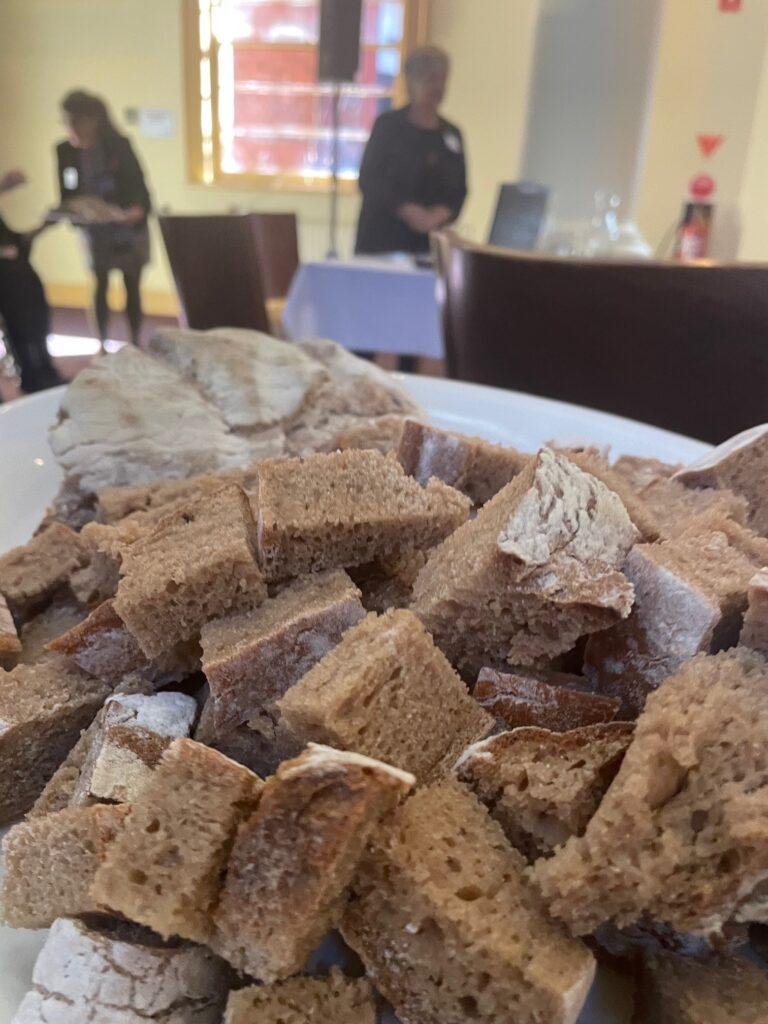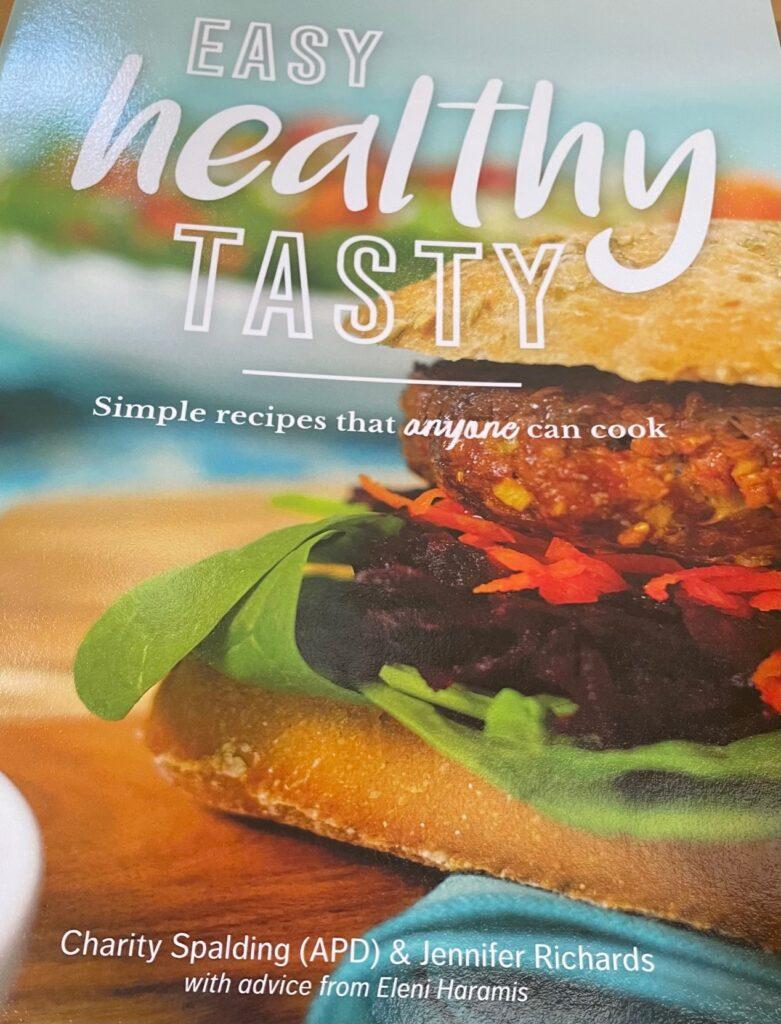Annie Smithers eased us into day three with visions of her farm Babbington Park on a cold crispy autumn morning “It’s hard to drag me out of the garden and into the kitchen on days like that”.
Annie reflected on her experience growing food on her small acreage in Lyonville. She discussed what it was used for historically compared with her current use and celebrated the fact that her 22 acres creates all she needs for her restaurant Du Fermier.
Annie reflected on the fact that her view of fruit and veg and their value has now changed. “I no longer think of fruit and veg as a commodity, I think of it as life”.
Our second session explored First Nations Gastronomy. Rodney Carter discussed Djaara fusion cooking and compared the journey of ramen from China to Japan, through to now with supermarket ramen now feeding a community. Djaara fusion cooking shares similarities. It can be practiced by any chef or cook from more than one background looking to inject their own unique identity through their respect of Djandak (country) Murrup (spirit) into their cuisine.
Jacob Birch a Gamilaraay man and Project Manager at Bruce Pascoe’s Black Duck Foods generously shared the rich history of cereal grains within Australia. Jacob is part of a project team currently creating a roadmap for the native grain industry, they are researching what is required to make it financially viable whilst ensuring it is First Nations led and governed.

Jacob, alongside several symposiasts, baked late into the night to provide us a taste of bread made using 20% arm grass from the Wurundjeri and 80% wheat. We also tried bread using Mitchell Grass and Button grass. Dja Dja Wurrung are also currently trialing growing and harvesting Kangaroo grass for bread making, the future of ancient grains is looking hopeful.
Our third presentation by First Nations was a reflection on an event held earlier this year called Djakitj Larr. It started with a community conversation between 100 food growers, First Nations, farmers, ecologists, and policy makers. From that conversation came the concept of Eating Djaara Country Healthy: The 50-year menu. The concept is that it will take 50 years to heal the land that we have damaged throughout the last 200 years. Jodi Newcombe (Carbon Arts/Australian Future Food Labs) and Rebecca Phillips (Dja Dja Wurrung/Australia Future Foods Lab) shared the journey of the Australian Future Food Lab in Djaara Country and offered insights into the role of arts and culture and gastronomy and the importance of leading with First Nations wisdom. Eating in abundance is the future of food.
Can you believe all of this was before morning tea? After some simple pleasures created by the students at Bendigo Tafe, we steamed ahead with gastronomy Justice. Jen Richards and Charity Spalding spoke to the importance for disability inclusive food media. Jen and Charity self-published one of the first inclusive cookbooks. Challenged by a friend with a disability, the women worked on creating a publication that included easy read, no chop recipes that made cooking achievable by all members of the community. Through Covid Jen and Charity created easy cook YouTube videos and were shocked and delighted to see there was a global appetite for the accessible recipes. A scone recipe in particular was viewed by 1.2 million people, many of those from the UK!

Creating taste was the subject mid-morning that looked at artisan smallgoods and organic gardening. John Downes discussed the history of bread and James Mele discussed all things salami..
Lunch was created by local foodie legends Food Fossickers. A picnic box full of all our local favourites – B & B Basil herb salad mix, Collins Honey, Pud for all seasons, Long Paddock Cheese, Bridgeward Grove olives, McIvor Salami, Castlemaine fine biscuit Co, Pink Muesli and Indulge Smoked salt chocolate. It’s amazing we made it to the afternoon sessions after a feast like that.

From France to Bendigo was an afternoon highlight. The team from Long Paddock Cheeses took us through the French inspired cheeses that they create with a focus on local botanicals, with a very distinct Australian identity. Ivan Larcher and Alison Lansley discussed the comparisons of French vs Australian made cheeses and the differences. In France there are 5000 farmstead cheesemakers. The industry is incredibly advanced and well supported. In Australia the industry is still in its infancy with only 45 artisan cheesemakers across the country.
What is the only thing better than eating cheese? Pairing it with wine of course, and that is exactly what we did. Amie Sexton walked us through a tasting of local wines from Lome’s award-winning selection of Viognier Marsanne and Shiraz. We were taught the right way to view the wine against a white background, we were taught how to swirl the glass and woosh the wine around in our mouth (woosh is not the technical term). We also learnt that if you taste vanilla tones, the wine was created in French Oak and if you taste coconut overtones then the wine was housed in American Oak.
For those who weren’t eating cheese and tasting wine they were being delighted by a tea tasting and learning all things tea. There was a presentation by olive oil sommelier Julie Howard from Bridgward Grove. Julie provided insight on the responsibilities that come with growing olives and the care that necessitates. Miin Chan, a medical doctor and researcher, shared her obsession with taste, food and nutrition and how that comes together in fermentation. Her research is directly related to the effects of fermented foods on chronic disease via gut microbiota. As we continue to see an increase in gut related illness and food intolerances, this is an incredibly interesting space.
Scholar and journalist Juan-Carlo Tomas created a pre-record that talked us through the garden as a larder, touchstone, and self: The Madrilène Huerto. We also learned about a wonderful initiative in Timor Leste by Agora Food Studio. The Timor Leste communities’ love of instant noodles was proving to be problematic, as this highly processed and low in nutrition food is contributing to malnutrition rates. To combat this, the team at Agora Food studio have started community noodle making workshops and noodle fairs. Their hope is to redefine contemporary food culture with community noodle-making as a way to showcase traditional, wild, and seasonal ingredients from each municipality across Timor Leste.
At the completion of day 3, Giles from Maidenii returned to tempt us with his latest creation, Roselle. This Campari-type spirit, when paired with soda water and an expertly cut wedge of orange (shout out to Rodney), becomes a mildly bitter sparkling treat.

Dinner did not disappoint. Held at the Bendigo Tennis Centre, the Loddon Campaspe Multicultural Services served us a feast for the eyes and the senses. We had a range of hors d’oeuvres including dahl puri – puffed Besan dough filled with black chickpeas, potato and spices. Aloo Tikki Chaat and Pakora.

The main meal was the real delight that showcased the culinary talents of the Local Karen and Indian communities. We enjoyed Bolani – an Afghan flatbread filled with spinach, leek and herbs, cooked in a tandoor. There was a fermented tea leaf salad, hand rolled cous cous (amazing!) and the real star was an 8-hour cooked Vindaloo Goat Curry. As we finished our meal on a range of sweet delights including traditional Indian sweets, milk cake, rice balls and baklava, we were treated to the philosophical insights of Author, Journalist, and literary critic Luke Slattery, and Amie Sexton played some delicious food-themed ditties on the ukulele and double bass.

0 Comments on "Symposium of Gastronomy – Day 3, Annie Smithers, First Nations Agriculture and all the Cheese"